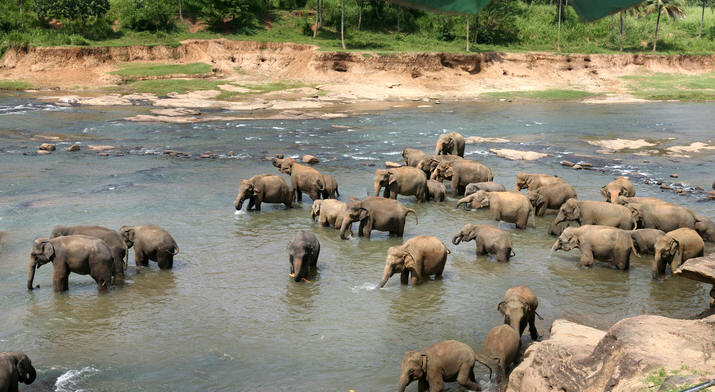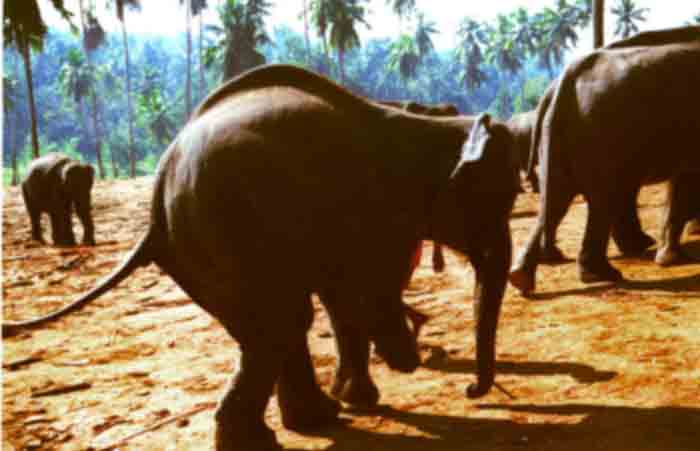Yesterday, February 18th, 2011 has brought ome more cheer to the Pinnawela Elpephant Orphanage with fifty-fifth birth of baby elpehant in its existence of 40 years.
The Pinnawela Orphanage which is located in the town of Kegalle, Sri Lanka, is one of the most special orphanage in the world. Because it not only earth gives home to retired, abused, orphaned abd sick Elephants but also provides the breeding ground for the largest animal in Earth.
The Elephant Orphanage was originally started in 1972 in the Wilpattu National Park to support, protect and foster those baby elephants whose mothers were either poached or died in the jungle of Sri Lanka. In 1975 the Department of Wildlife Conservation, Sri Lanka relocated the orphanage to Pinnawela on a 25-acre (10 ha) coconut plantation on the Maha Oya river. At that time the orphanage had just five baby elephants. In 1982, the authorirites launch a breeding program in the Orphanage, which increased the number of elephants in Pinnawela gradually. Currently, the orphanage has 86 elephants including the cub borned yesterday. There are number of pregnant Elephants that are on wait to add more elephant population to the orphanage in coming months.
Asiatic Elephants are known for their intelligence , calmness and domesticating capabilities. They show emotions like humans. They cry, play, have incredible memories, and laugh. In the Indian sub-continent Elephants has been playing important role in the social culture since ages. Sri Lanka is no different in that and the Panniwela Orphanage is a by-product of this culture. Though the Orphanage also has an tourism and monetary angle, it has survived for decades due to the local human bonding with elephants.
Unfortuantely the lack resources felt by both parties, human and wild Elephants, the conflicts between the two has increased over the years. Sri Lanka , home to around 3,000 wild elephants, see around 150-200 deaaths of wild elephants every years due to this conflict, against around 60-80 human casualities. Apart from the conflicts the political volatility and civil war in region injured and killed. The responsibilities of the orphanage is increasing with the increasing bad breaths between the two species. More number of baby elephants are coming into the orphanage every year due to these killings.
There Elephant Orphanage witnessed many emotional stories of Elephants over the decades. ‘Sama’ a female Elephant and a victim of war, came to the orphanage in 1995. She had her right front foot blown away by a landmine when she was a two year old baby. She was well cared for, and grew up using her three legs and has reached the age of thirteen. Though in fututre she may undergo severe complication for her unbalanced body, she is given all the possible care by the orphanage. ‘Raja’ who was born blind in wild is also taken special care in the orphanage. He is not taken to bath with other elephants for his inability and also given special love and treatment. The youngest orphan in the orphanage is just a year old baby taken into Pinnawela in December, 2010.
The Elephants at Pinnawela are provided as much natural condition as possible. They mostly roam freely in parkland, are ‘herded’ by their mahouts (keepers) just before being taken to feeding sheds. The elephants are taken to the near by Maha Oya river twice a day for bath. All the babies under three years of age are still bottle fed by the mahouts and volunteers. Each animal is also given around 76 kilograms (170 lb) of green food a day and around 2 kg (4.4 lb) from a food bag containing rice bran and maize and enough water from the river. Jackfruit, coconut, kitul, tamarind, banana and grass form the bulk of the green food given to the elephants at Pinnawela.
The breeding program in the Orphanage was started in 1982. Initially the breeding animals consisted of males Vijaya and Neela and females Kumari, Anusha, Mathalie and Komali. Vijaya was the first father in the orphanage. He with Kumari, a female elephant, have produced three calves at intervals of five and four years. With the fifty-fifth birth yesterday, it has produced more than twenty second generation Elephants.
Pachyderm, another innovation from the orphanage, is producing industrially successful Elephant Dung Papers. More than just a novelty stationery item, pachyderm paper could prove an important source of income to the villagers – & thus a significant help in conservation measures.
There are criticisms on the topics like chained Elephants, or forcing baby elephants to pose in tourists’ photo shots. But these can be neglected compared to the good work done by the orphanage. There is also need of chaining some of the Elephants coming fresh into the orphanage for the security of other elephants and mahuts, until they are tamed. Whatever may be the arguments, one thing to be agreed is that this small place in Sri Lanka is more home than a wild to many elephants. They are born, grown up in this world and may not be able to survive in wild. They now carry special bond with the mahuts and other workers in the orphanage. Its really wonderful to see innocent and cute baby elephants playing and enjoying life after losing their motherly love. They find love and security in the hands of the people.
We hope the orphahnge will keep doing the holisitc job and help more innocent and wild animals in future.




Recent Comments